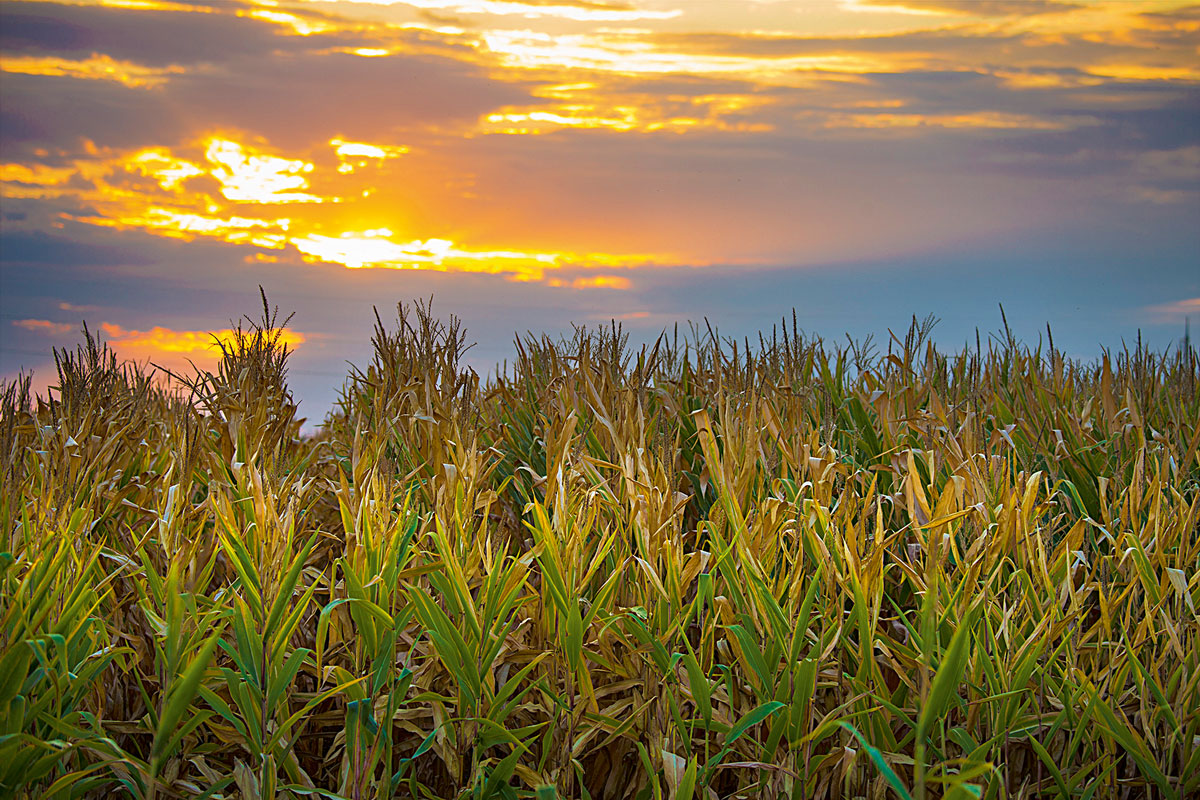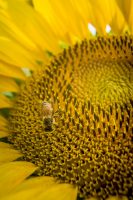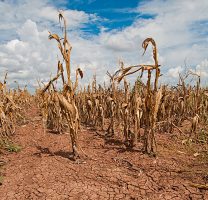Agriculture of the future
Science and technology for sustainable agricultural development

Guaranteeing access to food for a growing human population – based on sustainability criteria and in the face of the climate change threat – is the main challenge for twenty-first-century agriculture. The solutions are inevitably complex, require a variety of coordinated measures, and essentially, are dependent on the progress of science and the development of technologies to make more efficient use of available resources to increase crop yields and food quality to feed the world. Technologies such as genomics, computing, robotics, and nanotechnology, along with their correct application – which will require highly qualified users – will also be crucial elements to reach these objectives.
Keywords: agriculture, food security, sustainability, climate change.
Introduction
Around 12,000 years ago, a project was born in the Middle Eastern Fertile Crescent that would completely change humanity. Some groups of hunter-gatherers began their first experiments with a new technology, agriculture, which would lead them to abandon their nomadic lifestyle and make much more efficient use of the solar energy that plants capture to grow and reproduce. Agriculture slowly gained ground – it took over 5,000 years until it dominated the activity of human populations in Europe – but it did so decisively, because its introduction increased the demographic, organisational, military, and technological capacity of those who practised it (Morris, 2014). The most obvious consequence is that it became the essential reason why the world’s population went from less than six million people 12 millennia ago to over 7,600 million today.
Later, agriculture arose independently in other regions of the world, but it always started with the domestication of some animals and plants among the small number of potentially domesticable species. These were different in each region, had the nutritious properties essential to maintain a growing sedentary population, and at the same time, allowed the harvest surplus to be stored and exchanged in trade. Some of these plants were cereals and legumes which served as the population’s primary source of carbohydrates and proteins, and these were complemented by several animals which completed and enriched the human diet while providing the energy necessary for agricultural activity: ploughing, moving water, transporting produce, grinding grain, etc. (Diamond, 1997). Agriculture incorporated other more questionable ingredients into the human lifestyle, such as the crowding of people and animals in often unhealthy conditions or the increasing degradation of the environment.
«One of the main current agricultural challenges is to ensure global food security now that the human population is expected to reach 9,000 million within thirty years»
At the beginning of the Industrial Revolution and with a better understanding of nature which allowed for major scientific discoveries, agricultural activity underwent enormous technological changes. The use of fossil fuels meant that animal force, including human strength, was progressively replaced by self-propelled machinery, which drastically reduced the number of people needed to feed the population and provided the necessary labour to the nascent industry populating the cities. In 2008, there were already more people in urban environments than in rural areas, and this upward trend is expected to reach 66 % by 2050, up from 34% in 1960.
Challenges for agriculture
The first of what I consider to be the three main current agricultural challenges is to ensure global food security now that the human population is expected to reach 9,000 million within thirty years. Today, agriculture provides enough food to feed all of humanity – the causes behind the malnutrition of around a billion people are to be found elsewhere – but by 2050, agriculture would need to produce between 60 % and 110 % more than in 2006 (Food and Agriculture Organization [FAO], 2016; Ray, Mueller, West, & Foley, 2013) to feed everyone. This means that, at least for the crops upon which we base our calorie and protein supply (maize, rice, wheat, and soybeans are the most representative), production would have to increase by around 2.4 % per year. This objective is implausible, considering that average growth has been much lower (0.9 %–1.6 %) in the last twenty years (Ray et al., 2013).

One third of agricultural production is destined to feed livestock and pets. The growing demand for meat products requires an increase in agricultural production. One gram of beef protein requires about 112 litres of water, while only 21 litres are required for a gram of cereal protein, which makes producing meat much more inefficient than producing grain. / USDA, Preston Keres
In addition, the quality of human food must be improved, not only by providing enough calories, but also by ensuring a varied and balanced diet, the availability of which is not guaranteed either. Another factor that aggravates the problem is the growing demand for meat products, driven by the increased spending power of part of the world’s population. This represents an additional drop in the efficiency of food production because meat production is much more inefficient than grain production – for instance, one kilogram of beef requires about 30 kg of grain, and one gram of beef protein requires 112 litres of water, while one gram of cereal protein requires only 21 litres (Foley, 2011; Mekonnen & Hoekstra, 2012).
The second challenge is that agricultural production must be based on sustainability criteria. The cultivated agricultural area is currently 38 % of the Earth’s total land area (excluding Greenland and Antarctica). This fact shows the impact agriculture has had on the environment, one which is greater than that of any other human activity. Although the cultivated area may increase, it does not seem likely that it will happen significantly so in the future, as can be inferred from the fact that it has only grown by 3 % in the last twenty years (Foley et al., 2011). The cost of adding new land may be too high in environmental and economic terms to yield a useful return, and the use of new arable land is partly offset by urban growth – often on the best cultivable land – or by the growth of non-food crops to produce bioenergy: only 62 % of agricultural production is for human consumption: 35 % is for domestic animals and 3 % for biofuel production (Foley et al., 2011).
The quality of water and soil and the preservation of biodiversity are among the essential elements for the sustainability of the agricultural environment. The importance of these elements has begun to be valued only recently, with the acceptance of evidence that the world is finite and the need to use and recycle available resources according to quality maintenance criteria. Water is essential for plant growth, yet its distribution on the planet is irregular, with areas where it is optimally available for agriculture or, much more frequently, others where there is too much or too little water. Water is often what determines whether agriculture can be practised or not, as well as which type of agriculture is appropriate. More than 70 % of available fresh water is used to irrigate crops, and while it is recycled, misuse can lead to major problems. One such problem is water pollution, which, apart from ruining the land and aquifers and contaminating vital areas such as river mouths, can reach the sea and drastically reduce biodiversity and make it difficult or impossible to practice another important food-generating activity: fishing.
«Only 62 % of agricultural production is for human consumption, 35 % is for domestic animals, and 3 % for biofuel production»
Some of the pollutants in water and soil are the same products we use to improve crop yields: phytosanitary products (insecticides, fungicides, herbicides, and antibiotics) as well as mineral and organic fertilisers. The former control pests, diseases, and weeds, which cause serious losses in agricultural production, but many of them are toxic to other plant and animal species and so put agricultural biodiversity at risk. In addition, other ecosystems are also at risk when these pollutants move via water, soil, or air. Fertilisers provide plants with easy access to the elements they need from the soil (nitrogen, potassium, and phosphorus are the most important) and create a suitable physical environment for root development, leading to vigorous growth and a high yield. However, it is currently estimated that about half of inorganic fertilisers are not used by the target plants and are either retained in the soil or transferred to other ecosystems (Foley, 2011).

Biodiversity is a crucial element for the existence and preservation of life and for the development of agriculture. The design of more productive farming depends on the diversity of flora and fauna and, therefore, also on the relationship between insects, fungi, and bacteria. / USDA, Preston Keres
Biodiversity is another crucial element for the existence and preservation of life. It is also essential for the development of agriculture itself: conventional strategies for creating improved varieties depend primarily on the natural variation of the genes of the cultivated species or of closely related ones, and on the potential variation generated by artificial mutagenesis – very little so far – as well as on the creation of new gene combinations through hybridisation and recombination. The design of more productive cultivation methods also depends on the diversity of each soil’s flora and fauna, on the relationships with the insects, fungi, and bacteria interacting with crops, with their predators and symbionts, etc. The destruction of biodiversity on Earth would be an impediment not only to the progress of agriculture; it would also lead to imbalances that could make the lives of many of the organisms inhabiting the planet (including us) unviable. At the very least it would contribute to the loss of some ecosystems and scenic beauty that would make the world a much less interesting place in which to live.
The third crucial challenge is climate change, brought about by recent alterations in the composition of the atmosphere. The increase in the concentration of carbon dioxide, methane, and nitrous oxide, among other gases, is responsible for the greenhouse effect which is resulting in an increase in air temperature. The use of fossil fuels is one of the main causes for the generation of these gases, as demonstrated by the fact that the energy sector is the main emitter (47 %), followed by transport (11 %). However, agriculture and forestry directly generate an important part (21 %) of these gasses, which could reach 30 % if we consider all the elements involved (food industry and transport, among others; FAO, 2016). Agriculture produces these gases mainly as a result of deforestation, animal production, and soil and nutrient management, particularly animal-based organic fertilisers.
The effects of climate change are already being felt around the world, especially in tropical areas such as Southeast Asia and sub-Saharan Africa, where extreme climatic events such as long droughts and floods have led to growing instability in the availability of food for populations that are already particularly afflicted by hunger and malnutrition. Global agricultural production is projected to continue until 2030, but it will decline dramatically in the following decades, to a lesser or greater extent, based on models with varying degrees of optimism about our ability to reduce greenhouse gas emissions and mitigate or adapt to their effects. In any case, not exceeding an average global temperature increase of 1.5°C is considered to be a good objective that would avoid major problems for humanity, but this cannot be done without substantial changes in the sectors causing the problem, including agriculture (FAO, 2016).
«The destruction of biodiversity on Earth would be an impediment not only to the progress of agriculture, it could also make the lives of many of the organisms inhabiting the planet (including us) unviable»
The role of science and technology
Can agriculture respond to these challenges? Or is the world heading towards a growing food deficit that could potentially lead to a period of hunger, migration, and increasing ungovernability? There is no clear answer, although this same question has been asked in the past, and fortunately, we have found answers, many of them unforeseen and all related to the progress of science and technology. This was the case of Malthus’s apocalyptic predictions about the future of the human population in the late eighteenth century. These predictions did not come true thanks to the progress of agronomy and several aspects of crop genetics, such as the use of fertilisers and pesticides and genetic improvement based on an understanding of the basic laws of heredity, which enabled the green revolution.
Scientific knowledge continues to exponentially grow and recent decades have seen an explosion of results and paradigm shifts in many fields. It seems that the twenty-first century will continue in the same vein and, although our understanding of plant and animal biology – the basis of agriculture – is greater, new discoveries continue to generate more questions than answers. A substantial part of this new knowledge has and will come from the interaction between biology and other new or old scientific areas, making multidisciplinary approaches to research increasingly necessary. Scientific advances lead to the technological innovations which will change agriculture in the coming years. Some of these technologies are described below.

The effects of climate change, such as long droughts or floods, have already started to be felt in many regions with extreme climate events. The picture shows the effects of the 2013 drought in a corn field in Texas (USA). / USDA, Preston Keres
Genomics
We have now sequenced the entire genome of many species, but we are only able to interpret a tiny part of the genetic message contained therein. The DNA sequence is the functioning basis of living organisms and the raw material for their diversity, so scientific work will continue to focus on studying this material in the coming decades. Advances in this field have made it possible to develop DNA modification technologies, which began with the first genetically modified plants almost four decades ago. Genetically modified crops occupy almost 190 million hectares (International Service for the Acquisition of Agribiotech Applications, 2017), 12 % of the total agricultural surface, but they have generated social rejection in some parts of the world, notably in Europe. Powerful new gene editing tools are likely to replace genetically modified crops because they allow targeted mutagenesis in which genes can be accurately modified, resulting in plants or animals containing no genes other than their own. The debate about these technologies has a strong ideological component, but the current scientific evidence indicates that they do not present clear risks to human health or the environment. It would be desirable for the current doubts about their use to fade away, because we cannot afford to discard potentially effective technologies when we need all the tools at our disposal to overcome our challenges.
Cheap, high-efficiency sequencing makes it possible to characterise a new and previously ignored environmental variable: the microbiome of soil, water, air, rumen, etc., with consequences that will lead to a greater understanding and control of the environment in which plants and animals live, as well as its relationship with genotypes. New aspects, such as the role of non-coding sequences in the genome, including transposons, or the importance of epigenetics as a factor in inheritance, open up additional questions to be resolved which may break or modify current paradigms, all with applied consequences. Finally, high-throughput phenotyping, which uses state-of-the-art computing and robotics, will make it possible to establish a finer resolution of the phenotype-genotype relationship and enable an early DNA-based phenotype prediction.
«We cannot afford to discard potentially effective technologies when we need all the tools at our disposal to overcome our challenges»
Computer science
The search, storage, visualisation, and integration of very different kinds of data (big data) related to agricultural activity and its accessibility for cultivated plots opens up enormous possibilities for much more efficient crop management, based on understanding the needs of each plant, in so-called «precision agriculture». The result involves a more careful use of essential inputs (varieties, water, fertilisers, means of sanitary control, etc.) and at the same time, ensures higher production. In addition, the design, testing, and refinement of predictive models for the evolution of crops or phenotypes based on genotypic and environmental data will result in new computer tools to aid decision-making, some of which are already starting to be useful for farmers and breeders.
Robotics
The mechanisation of agriculture will continue with the development and construction of machinery for precision farming, food processing, measurement of the essential components of environmental heterogeneity, or of basic and processed foods, with the aim of correcting possible deficiencies, improving food hygiene, and increasing the yield, quality, and health of food production and storage (King, 2017). The above-mentioned high-throughput phenotyping heavily relies on the automation of basic operations and the integration of other elements, such as advances in digital imaging and the use of drones to capture detailed images at the right times.

Scientific advances in fields such as genomics will produce changes in agriculture in the next few years. The debate on new gene-editing tools has a strong ideological component, but the current scientific evidence indicates that they do not present clear risks to human health or the environment. / USDA, Preston Keres
Nanotechnology
There are several potentially-useful agricultural applications of this technology (Fraceto et al., 2016). Among others, the formulation of pesticides based on nanomaterials for the control of pests and diseases; the use of nanoparticles to slowly dose nutrients and water to plants; the improvement of soil quality; the development of biosensors to measure the hydric or nutritional state of plants (as required in precision agriculture); the transfer of genes or DNA via microparticles; the use of nanoparticles in extending the shelf-life of fruits and vegetables and, in general, improving food quality.

Computing and robotics open new possibilities for efficient crop management. The picture shows a robot developed by the Polytechnic University of Valencia (Spain) monitoring vineyard parameters likes water availability, leaf temperature, and plant vigour. / USDA, Preston Keres
Conclusion
There are no simple formulas when it comes to tackling the immediate challenges of agriculture. The actions that need to be undertaken are all complex and require coordinated implementation in areas such as politics, sociology, economics, technology, education, etc. Among others, these actions should involve increasing agricultural productivity, considering that there is a lot of room for improvement in raising the crop yields in areas of the world with the lowest production to meet those where production is highest, as well as improving crop yields in regions where they are already high. It is also important to stop the expansion of agriculture, especially where it destroys rainforests and savannahs; to produce more with less, i.e., to maximize the yield per unit of water, fertiliser, and energy spent; switching to diets containing less animal protein, higher efficiency animal protein sources, or with synthetic proteins; reducing food waste, be it at the farm, in the supermarket, or in consumer’s homes. Consumers should also have access to objective, standardised information on whether the food they buy has been produced according to specific sustainability criteria, avoiding vague labels such as «organically farmed» or «locally produced».
This will undoubtedly require strengthening and focusing research on appropriate scientific areas, considering that the resulting technology will require highly educated users. Given that one of the critical aspects is the increase in productivity in developing countries, solutions will have to be implemented respecting the social structure of these communities, and so, training farmers will be crucial. The latter is a truly difficult challenge, which will require significant investments and policies tailored case-by-case. Whether we can maintain a large human population and overcome the scourges of hunger and malnutrition will ultimately depend on these efforts.
REFERENCES
Diamond, J. (1997). Guns, germs and steel: The fates of human societies. New York: Norton.
Foley, J. A. (2011). Can we feed the world and sustain the planet? Scientific American, 305(5), 60–65.
Foley, J. A., Ramankutty, N., Brauman, K. A., Cassidy, E. S., Gerber, J. S., Johnston, M., ... Zaks, D. P. M. (2011). Solutions for a cultivated planet. Nature, 478, 337–342. doi: 10.1038/nature10452
Food and Agriculture Organization. (2016). The state of food and agriculture. Climate change, agriculture and food security. Rome: Food an Agriculture Organitzation of the United Nations.
Fraceto, L. F., Grillo, R., De Medeiros, G. A., Scognamiglio, V., Rea, G., & Bartolucci, C. (2016). Nanotechnology in agriculture: Which innovation potential does it have? Frontiers in Environmental Science, 4. doi: 10.3389/fenvs.2016.00020
International Service for the Acquisition of Agribiotech Applications. (2017). Global Status of Commercialized Biotech/GM Crops in 2017. ISAAA Briefs, 43. Retrieved from http://www.isaaa.org/resources/publications/briefs/53/download/isaaa-brief-53-2017.pdf
King, A. (2017). Technology: The future of agriculture. Nature, 544, 21–23. doi: 10.1038/544S21a
Mekonnen, M. M., & Hoekstra, A. Y. (2012). A global assessment of the water footprint of farm animal products. Ecosystems, 15(3), 401–405. doi: 10.1007/S10021-011-9517-8
Morris, I. (2014). Why the West rules... for now? New York: Farrar Strauss & Giroux.
Ray, D. K., Mueller, N. D., West, P. C., & Foley, J. A. (2013). Yield trends are insufficient to double global crop production by 2050. PLOS ONE, 8(6), e66428. doi: 10.1371/journal.pone.0066428





